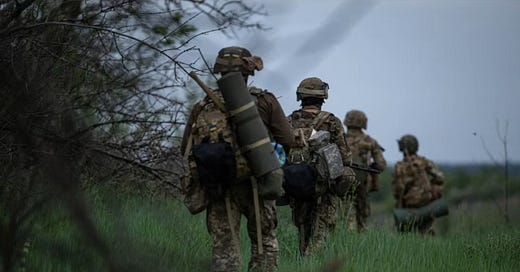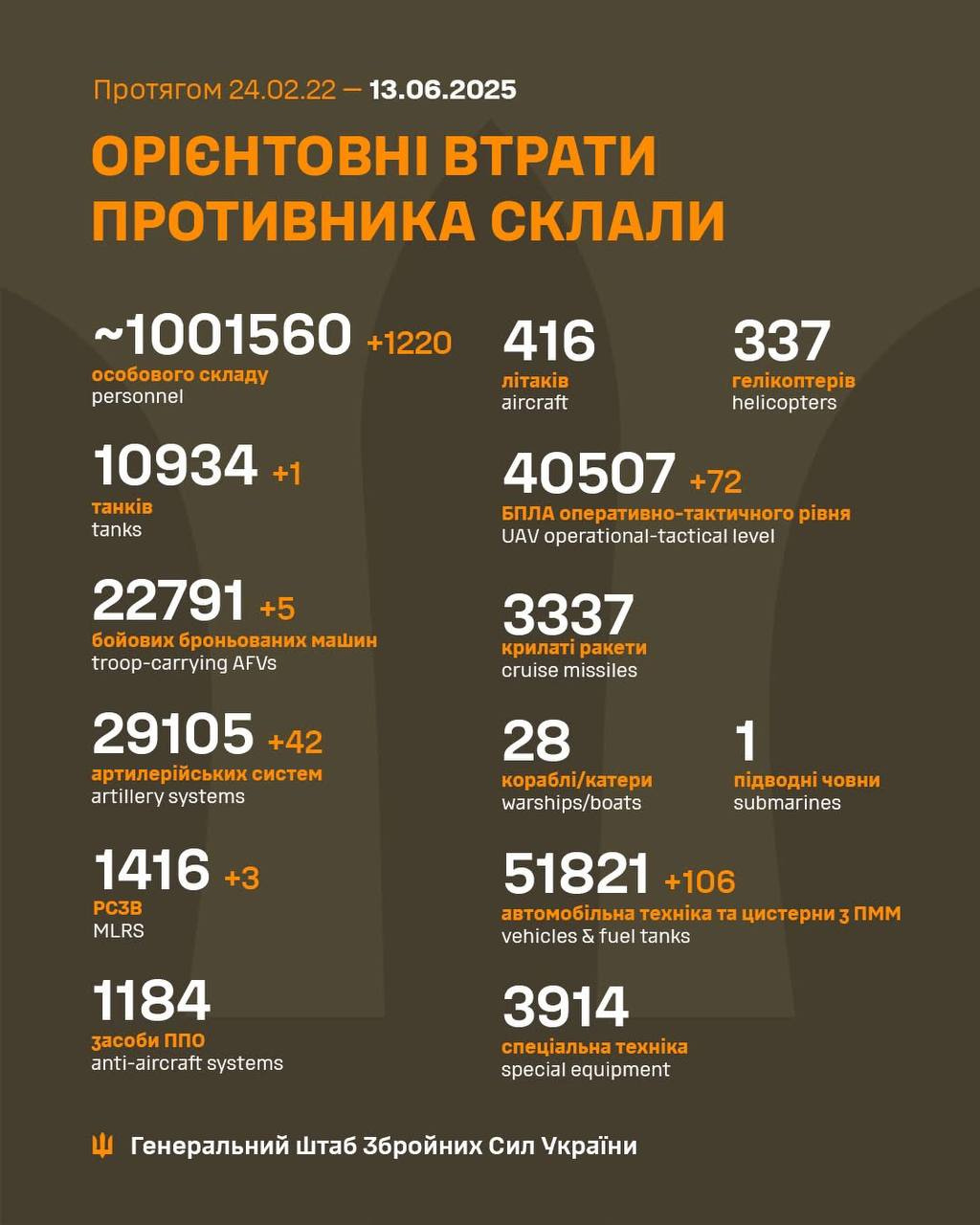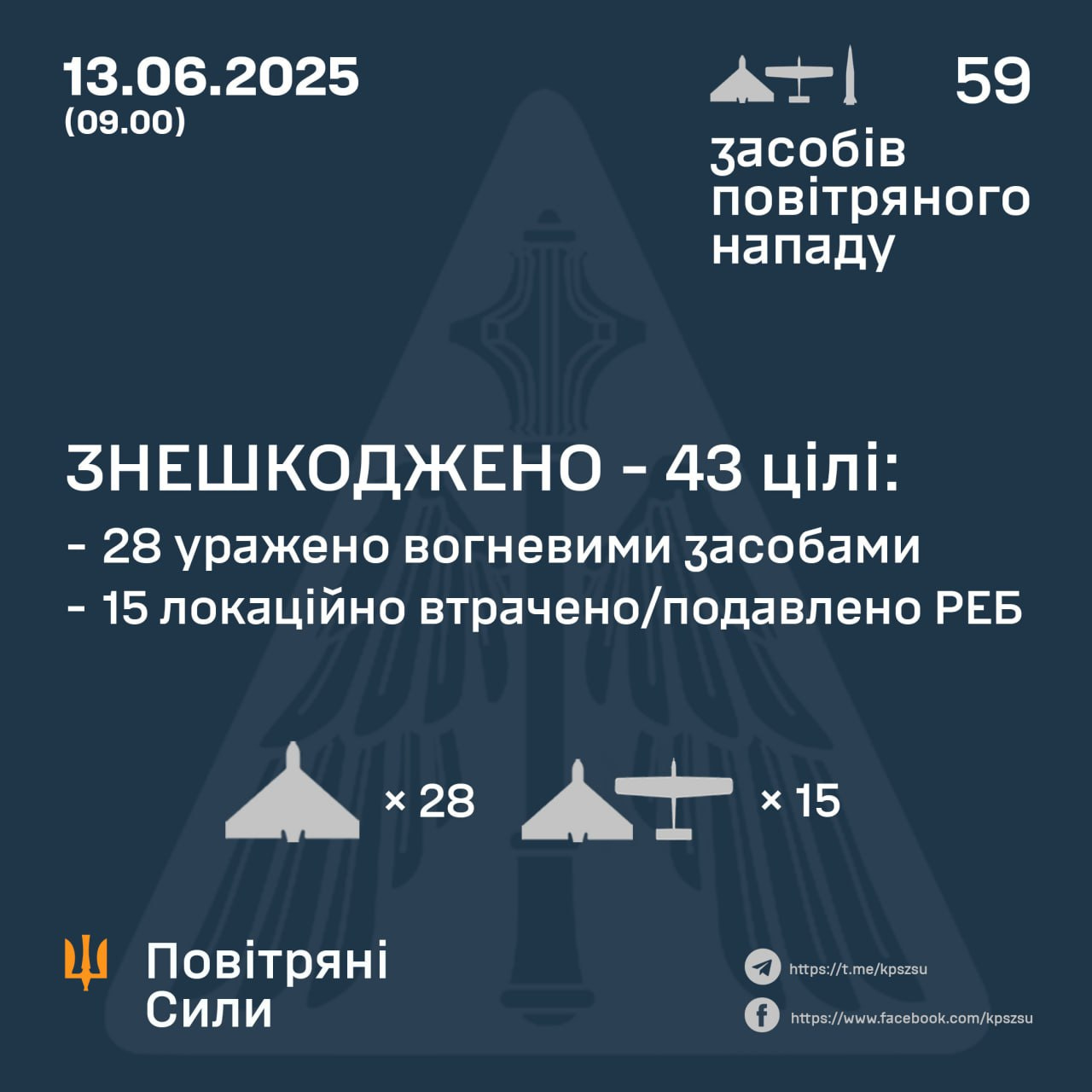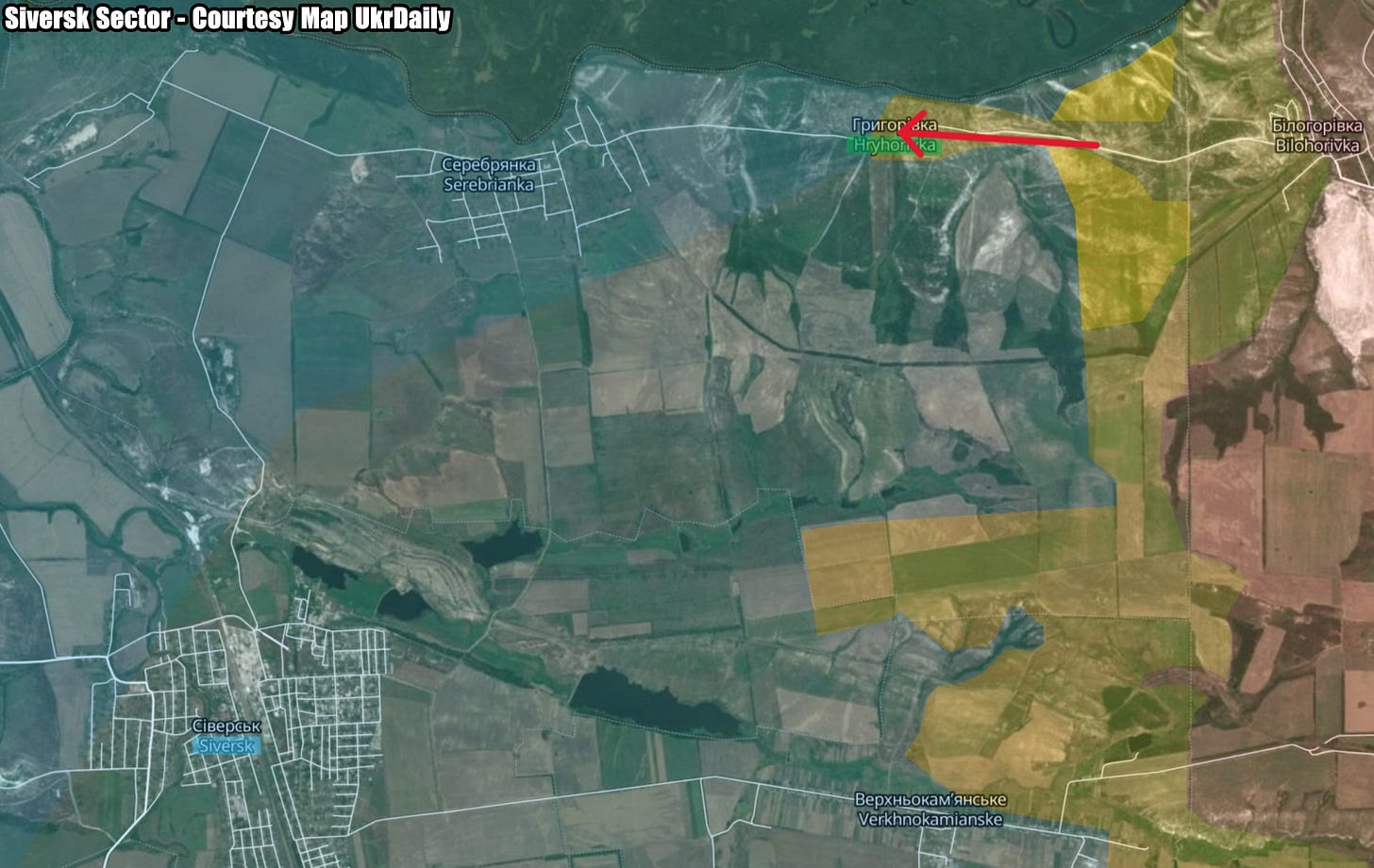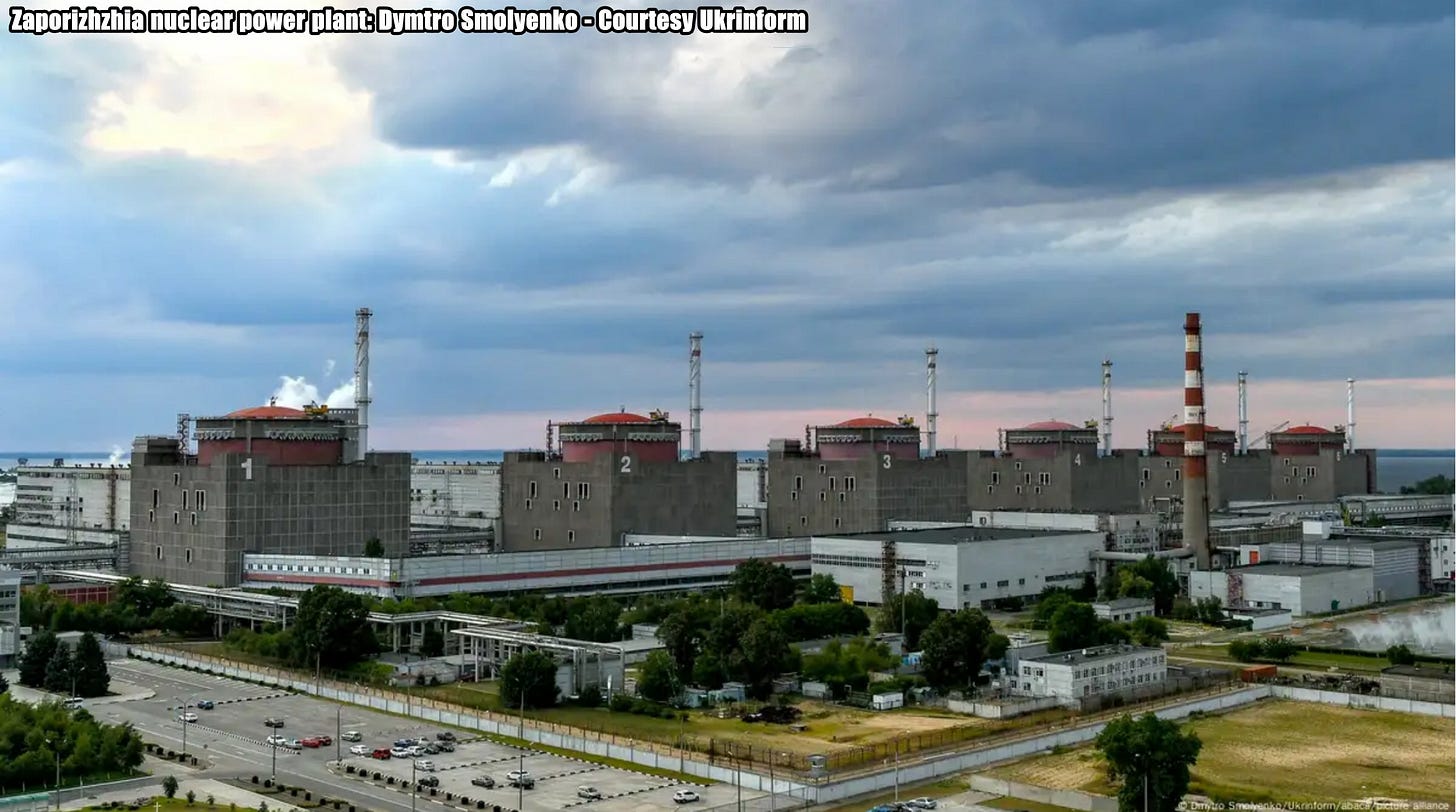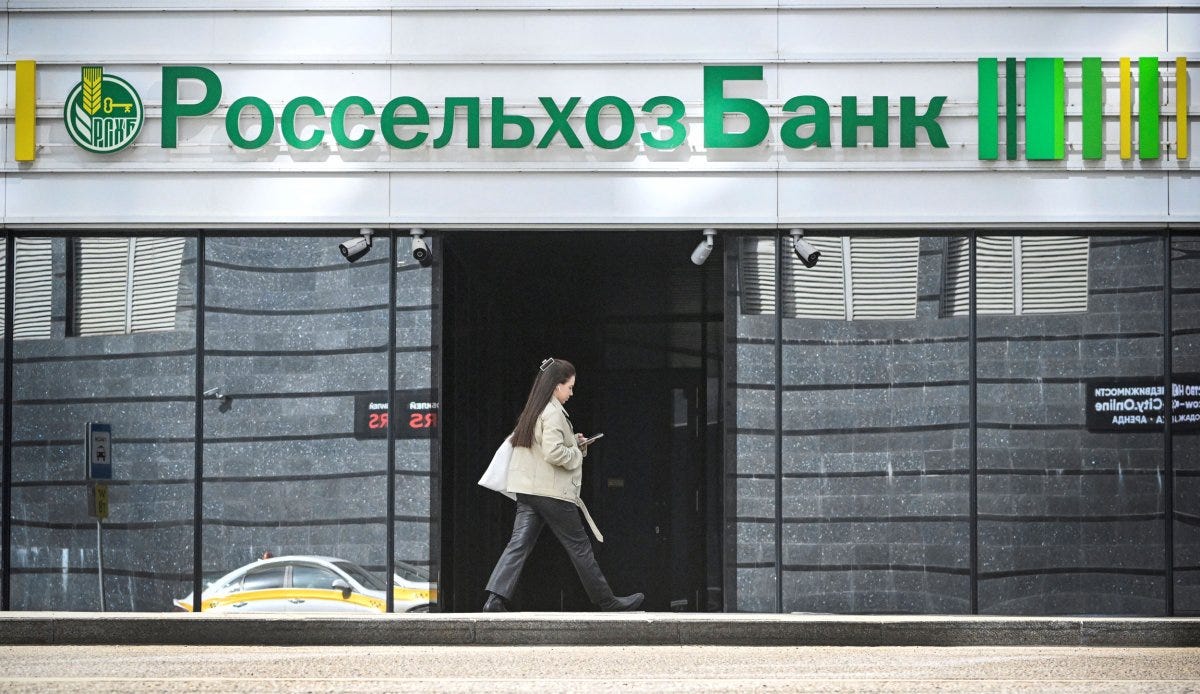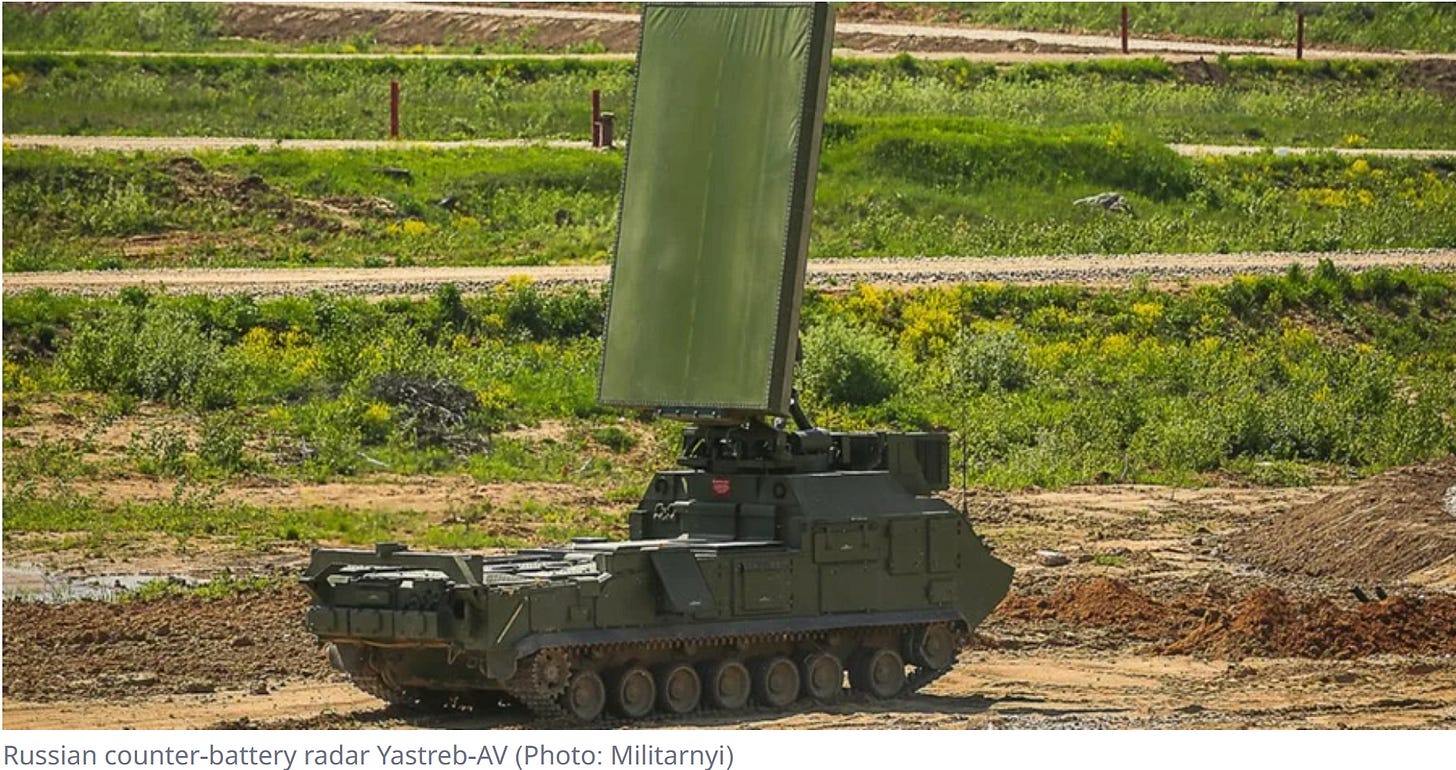Slava Ukraini! In early 2022 I began a Telegram channel aggregating news from a number of sources daily on the war in Ukraine. In June 2023 I began providing a daily draft for the Ukraine War Brief Podcast collecting news from over 70 sources daily, which formed the basis of the script. While the Podcast no longer exists I have continued to make this Brief available for my subscriberss here on Substack and anyone who wishes to keep up with the news from the war.
If you find the Brief informative I would appreciate it if you shared it with others.
All the latest news on the Russo-Ukraine War 6 days per week
ALONG THE CONTACT LINE
GSAFU Morning Report
For: Jun 13, 2025
The General Staff of the Armed Forces of Ukraine in its Operational Information update at 08:00 on Jun 13 stated that day 1206 of the full-scale invasion of the Russian Federation against Ukraine had begun.
The situation on the line of combat remains tense in some sectors. Ukrainian defenders continue to actively counteract the Russian aggressor, causing them significant losses in personnel, equipment and technology. Exhausting the enemy along the entire front line and continuing to disrupt the plans of Russian occupiers to advance deeper into the territory of Ukraine.
Over the past 24 hours, aviation, missile troops and artillery of the Defense Forces have hit 19 areas of personnel and equipment concentration, 4 artillery and two control points of Russian invaders.
During the past day, 209 combat engagements took place.
Over the past 24 hours, the enemy carried out 78 air strikes, used 3,135 attack drones and fired approximately artillery 5,200 shells across the positions of Ukrainian forces and civilians.
Air Force Daily Report
43 ENEMY UAVS DESTROYED
➖➖➖➖➖➖➖➖➖
On the night of Jun 13 (from 22:30 on Jun 12), the enemy attacked with 55 Shahed attack UAVs and simulator drones of various types from the directions: Kursk, Millerovo, Primorsko-Akhtarsk - Russia, as well as 4 Iskander-M/KN-23 ballistic missiles from the Voronezh and Rostov regions - Russia.
The main areas of the air strike are Kharkiv, Donetsk and Dnipropetrovsk regions.
The air attack was repelled by aviation, anti-aircraft missile troops, electronic warfare and unmanned systems units, and mobile fire groups of the Defense Forces of Ukraine.
As of 09:00, air defenses have neutralized 43 enemy Shahed UAVs (and other types of UAVs) in the north, east, and south of the country. 28 were shot down by fire weapons, 15 were lost/suppressed by electronic warfare.
Enemy air attack targets were recorded in 9 locations.
Combat Operations in the Russian Federation
There has been no significant change in the combat environment in this sector since our last report.
The Khortytsia operational-strategic group
(Responsible for the northeastern part of Ukraine. )
Sumy Sector: Russian forces recently advanced in Sumy Oblast.
Geolocated footage published on Jun 12 shows Ukrainian forces striking Russian positions south and southwest of Oleksiivka (north of Sumy City), indicating that Russian forces recently seized the settlement.
Additional geolocated footage published on Jun 12 indicates that Russian forces recently advanced northwest of and within central Kindrativka (west of Oleksiivka) and south of Andriivka (southwest of Oleksiivka).
Siversk Sector: Russian forces recently advanced in the Siversk direction.
Geolocated footage published on Jun 12 indicates that Russian forces recently seized Hryhorivka (northeast of Siversk).
Toretsk Sector: Ukrainian forces recently advanced in the Toretsk direction.
Geolocated footage published on Jun 11 indicates that Ukrainian forces recently advanced southeast of Dyliivka (north of Toretsk).
The Tavria operational-strategic group
(Responsible for the central-eastern and southeastern part of Ukraine.)
There has been no significant change in the combat environment in this sector since our last report.
The Odesa operational-strategic group
(Responsible for Kherson, Qırım, (also known as Crimea) and the Black Sea.)
There has been no significant change in the combat environment in this sector since our last report.
TEMPORARILY OCCUPIED TERRITORIES
Russia continues to attempt to restart the Russian-occupied Zaporizhzhia Nuclear Power Plant.
The Institute for the Study of War (ISW), a US based think tank, in its Jun 12 Russian Offensive Campaign Assessment reported that The International Atomic Energy Association (IAEA) continues to condemn any Russian attempts to restart the Russian-occupied Zaporizhzhia Nuclear Power Plant (ZNPP).
Forty-eight member states of the IAEA issued a statement calling for all reactors at the ZNPP to remain in cold shutdown mode until Ukrainian regulatory authorities regain control of the plant. The statement assessed that Russian attempts to restart the ZNPP would be "completely unacceptable" and contrary to IAEA and United Nations (UN) resolutions.
ISW observed reports in late May 2025 that Russia laid powerlines in occupied Ukraine, likely in order to connect the ZNPP to the Russian power grid. Russian state nuclear energy operator Rosatom Head Alexei Likhachev claimed on May 21 that Rosatom had developed a plan to bring the ZNPP to "full capacity."
THE HOME FRONT
Russia kills at least 4, injures 24 across Ukraine over the past day.
At least four civilians were killed and 24 injured over the past day in Russian attacks across Ukraine, the Kyiv Independent reported citing Ukrainian officials on Jun 13.
In Kherson Oblast, Governor Oleksandr Prokudin said Russian troops shelled and launched drone and air strikes on dozens of settlements, including Kherson city. The attacks hit residential areas and critical infrastructure, damaging four apartment buildings and 13 houses. One person was killed and seven were wounded.
In Kharkiv Oblast, Governor Oleh Syniehubov reported that seven civilians were injured, including an 11-year-old child, during Russian attacks on seven settlements. Russian forces used 16 unguided rockets, six guided bombs, and over 20 drones, including Shaheds and first-person view (FPV) units. Civilian infrastructure, including houses and factory buildings in Kupiansk, Izium, and Bohodukhiv districts, sustained significant damage.
In Sumy Oblast, two people were injured when a Russian drone struck civilian infrastructure in the Mykolaivka community, regional officials said. Over the past 24 hours, Russia carried out more than 50 attacks on 25 settlements using FPV drones, multiple-launch rocket systems, and guided bombs.
In Zaporizhzhia Oblast, Governor Ivan Fedorov said one person was killed and three injured in Russian attacks on the region. Russian forces launched nearly 500 strikes across the region, including 283 drone attacks, mainly FPV types, and 10 air strikes.
In Donetsk Oblast, Governor Vadym Filashkin said two civilians were killed, while five others were injured across the region.
RUSSIAN WORLD
Russian credit debt soars to 2bn rubles daily
Russians are increasingly paying on loans that they scored during the boom 2023 – the first half of 2024. Mortgage, consumer and car loans are now « maturing », states Central Bank. The volume and share of problem loans are growing, in the I quarter they increased by almost 200 billion rubles, or about 2 billion rubles. in a day. The Moscow Times reports.
The deterioration in portfolio quality is reflected in the risk cost ( the ratio of reserve costs to portfolio size ). Banks had to create more reserves, as a result, in three months the cost of risk in the retail jumped from 2.1% to 3.6%, the Central Bank notes. According to him, this is « significantly higher than the average historical value of », which is approximately 2%.
The worst thing is with unsecured consumer loans. Deterioration of quality and growth in the volume of overdue loans occurs mainly there, writes the Central Bank. Problem loans increased over three months by 139 billion rubles, or by 1.7 percentage points ( p. ) up to 10.5%.
He cooled this segment for a long time and achieved his goal: the portfolio has been falling since September last year and decreased by 2% in the IV quarter of 2024 and by 1.4% in the first quarter, when the issues were in the third ( 34% ) less than in the previous one. The Central Bank restricts banks from lending to people with high debt burdens, many of which cannot be overlooked. The rest avoid loans at current rates. According to the Central Bank, the total cost of ( PSK ) unsecured consumer loans for the quarter increased by almost 10 percentage points: up to 40.2% from 30.5% in the IV quarter. In part, this is « paper » growth: banks that understated PSK on credit cards began to correctly calculate it, but first of all – the consequence of the lifting of the moratorium on limiting CPM due to rising market rates. « This allowed banks to adjust to the current market conditions », – writes the Central Bank.
Another 14 billion rubles. bad debts in – from 79 to 93 billion rubles increased, and their share in three months became more by 0.5 percentage points. ( 3.6% April 1 ). As in consumer loans, the arithmetic effect affected: the portfolio of car loans also went to a reduction of ( by 1.2% per quarter ), and against this background « matured » loans are more pronounced. The Central Bank expects that by the end of the year the market will recover somewhat, especially taking into account the discounts that car dealers began to offer, but portfolio growth, if any, then « withheld » due to high rates and prices for cars, as well as restrictions on the Central Bank.
The share of problem mortgages, according to the Central Bank, added 0.2 percentage points and reached 0.9%. The Central Bank did not name absolute figures, but at the end of March there were 20.1 trillion rubles on the balance sheets of mortgage banks. ( the portfolio itself increased by « modest » 0.4% ). Based on this, bad debts could grow by about 40 billion rubles. The total increase in bad debts for the quarter, thus, turns out 193 billion rubles.
The Central Bank does not see this as a big problem for banks: most of these debts are covered by reserves, and its restriction on lending to issuing risky loans – to credited people or with low ( less than 80%) the ratio of the value of collateral to the loan size – will lead to the fact that further « to mature » there will be less loans. « Change in the credit quality of retail portfolios so far meets expectations, » – writes the Central Bank. According to his forecast, the cost of risk in retail for 2025 will be 2.5 – 2.9%. Nevertheless he returned the debt burden of citizens in the list of major financial vulnerabilities ( there are six in total ).
Siberian Police Arrest Woman for Calling Russian Soldiers ‘Murderers’
Police arrested a woman in Siberia’s Irkutsk region after she posted a video on social media criticizing Russia Day and soldiers fighting in the war against Ukraine, the Moscow Times reports.
Maria Makhmutova, 35, was arrested on Friday, with law enforcement authorities saying she “behaved inappropriately and tried to run away several times” as officers escorted her from her apartment to a local police station.
In a video released by the Irkutsk region branch of Russia’s Interior Ministry, police can be seen ripping Makhmutova’s door open with a sledgehammer and a pick as she refuses to let them inside. The woman appears distraught as police enter her home, though she tells officers that she “feels better” since they are filming her.
As she was taken in for booking, Makhmutova appeared to physically struggle with police as they escorted her. In the video, she gave officers the middle finger as they took her photo at the police station.
Friday’s arrest comes after Makhmutova posted a video on social media the day before, where she expressed anger over Russia Day, celebrated annually on June 12, and the war in Ukraine.
“What kind of holiday is this, for f***’s sake? A f****** awesome holiday — Russia Day. What the f**** are you proud of… that you have to kill people to buy a new ride and an apartment?” she says in the video.
“To drink like there’s no tomorrow and to wear your f****** medals?” she continues. “You’re f****** murderers. If all the [soldiers fighting in Ukraine] die tomorrow, I’ll have myself a glass of wine.”
Makhmutova said Friday before her arrest that she called the police herself because she had received threats over her video. In one video posted on her social media account, she threatened to cut her wrists on camera.
RELATED INTERNATIONAL NEWS
Germany to supply new Iris-T air defense systems to Ukraine, rules out Taurus missiles.
Germany will deliver new IRIS-T air defense systems to Ukraine under a three-year supply plan, President Volodymyr Zelenskyy said during a joint press conference with German Defense Minister Boris Pistorius, who added Berlin has no plans to provide Taurus long-range missiles, the Kyiv Independent reported.
The announcement comes amid escalating Russian aerial assaults, including a June 10 missile and drone strike on Kyiv, one of the largest since the start of the full-scale invasion.
"We are grateful for the supply of IRIS-T air defense systems," Zelenskyy said on June 12. "We understand that deliveries are currently being planned... for the next three years. This is very important assistance."
The IRIS-T is a German-made medium-range surface-to-air missile system capable of intercepting drones, aircraft, and cruise missiles.
Pistorius confirmed the delivery timeline but firmly ruled out the possibility of sending Taurus missiles — weapons Kyiv has repeatedly requested to strike deep into Russian territory.
"You asked me whether we are considering this, and my answer is no," Pistorius said.
Before taking office, German Chancellor Friedrich Merz signaled openness to lifting former Chancellor Olaf Scholz's ban on the missiles. That stance has not yet resulted in a policy shift.
Ukraine has already received long-range missiles — including ATACMS from the U.S. and Storm Shadow and SCALP from the U.K. and France. Initially restricted to use within Ukrainian territory, Western allies only began easing those limitations in late 2024.
Germany is Ukraine's largest military donor in Europe. Pistorius said that Berlin will provide 9 billion euros ($10.4 billion) in aid this year, with investments in defense production being considered. The total includes an additional commitment in military aid worth 1.9 billion euros ($2.2 billion).
"Today, we discussed that this aid will continue," he said. "We agreed on additional investments in production... both in Ukraine and in Germany."
Zelenskyy visited Berlin on May 28 for talks with Merz, part of an ongoing effort to bolster Ukraine's defense industry amid uncertainty over U.S. support under President Donald Trump.
Most G7 members ready to lower Russian oil price cap without US.
Most countries in the Group of Seven nations are prepared to go it alone and lower the G7 price cap on Russian oil even if U.S. President Donald Trump decides to opt out, Reuters reported on Jun 12 citing four sources familiar with the matter said.
G7 country leaders are due to meet on June 15-17 in Canada where they will discuss the price cap first agreed in late 2022. The cap was designed to allow Russian oil to be sold to third countries using Western insurance services provided the price was no more than $60 a barrel.
The European Union and Britain have been pushing to lower the price cap for weeks after a fall in global oil prices made the current $60 cap nearly irrelevant. The cap is aimed at curbing Russia's ability to finance the conflict in Ukraine.
The sources, who declined to be named, said the EU and Britain are ready to lead the charge and go it alone, backed by the other European G7 countries and Canada.
They said it is still unclear what the U.S. will decide, though the Europeans are pushing for a united decision at the meeting. Japan's position also remains uncertain, they said.
"There is a push among European countries to reduce the oil price cap to $45 from $60. There are positive signals from Canada, Britain and possibly the Japanese. We will use the G7 to try to get the U.S. on board," one of the sources said.
Asked about Trump’s support for a Russian oil price cap, a White House official said the president looks forward to a “robust discussion on key economic and geopolitical issues.”
During the G7 finance ministers meeting in the Canadian Rockies last month, U.S. Treasury Secretary Scott Bessent remained unconvinced there was a need to lower the cap, according to sources.
However some U.S. Senators may endorse the idea, including Lindsay Graham, who in recent weeks told reporters he supports lowering the cap. Graham is pushing a hard-hitting new set of Russia sanctions that could impose steep tariffs on buyers of Russian oil.
The Canadian foreign ministry was not immediately available for comment.
The EU has proposed lowering the price to $45 a barrel in its latest 18th package of sanctions. The package must have unanimity from member states in order for it to be adopted, which could take several weeks.
Russia's largest export grade, Urals, trades at around a $10 a barrel discount to the Dated Brent benchmark out of Baltic ports. Brent futures have been trading below $70 a barrel since early April.
Sources said Washington's buy-in was not essential to lower the cap owing to Britain's dominance in global shipping insurance, and the EU's influence on the Western rules-abiding tanker fleet.
The U.S., however, does matter when it comes to dollar-denominated payments for oil and its banking system.
The EU and its Western allies have been progressively cracking down on Russia's shadow fleet of tankers and related actors, which work to circumvent the cap.
The pressure has started to hurt Moscow's revenues and Western allies hope this will push more of the oil trade back under the cap. Russia's state-owned oil producer Rosneft reported a 14.4% slump in profits last year.
Hackers Expose International Partners of “Russian Helicopters” Russian Defense Giant.
Hackers successfully obtained documents from the Russian aviation holding company, Russian Helicopters, revealing details about the countries and companies collaborating with Russia, Miltarnyi reports.
The international intelligence community InformNapalm and the group MILITANT INTELLIGENCE publicly released parts of the leaked materials.
Over the past several months, a coordinated effort under the joint operation OpsHackRussia’sDay has compromised an extensive network of Russian corporations connected to the nation’s defense-industrial sector.
Specifically, hackers gained access to the systems of the Russian aviation holding company, Russian Helicopters, which unites enterprises involved in the production and maintenance of helicopters.
As a result of the breach, international contracts, supply routes, bank receipts, accounts from various countries, as well as archives of correspondence with embassies and the Russian Ministry of Defense were obtained.
“Complete details have been obtained for every contractor and tender. All clients and internal corporate correspondence, including employees, schedules, routes, and stamps, have been uncovered. Information reveals where repairs take place, how funds are received, which banks are involved, how coordination with the Ministry of Industry and Trade occurs, and who is sent on business trips,” InformNapalm reported.
The documents indicate that Egypt is one of the key logistical hubs through which maintenance of Mi-17V-5 helicopters is performed. Bulgaria is also involved as a partner in supply chains, approvals, and repair logistics.
“We have data on Azerbaijan and North Macedonia — all of which is documented. The schemes also involve the Indian company RAWAN HANS, Algerian procurements, Indonesian channels, and routes through third countries,” InformNapalm noted.
All the documents contain signatures and direct involvement of directors, top managers, deputies, and officials from several foreign states.
The community noted that some of the data obtained had already been used to support Ukraine’s defense.
Recently, Ukrainian cyber specialists also attacked the resources of the Tupolev Design Bureau — a leading Russian aviation company. Specifically, this included internal correspondence of the company’s leadership, personal data of the design bureau’s staff, residential addresses, resumes of engineers and designers, procurement records, minutes of closed meetings, and more.
MILITARY & TECH
Ukrainian forces destroy unique Russian Yastreb-AV radar.
The Ukrainian Defense Forces have critically damaged the advanced Russian Yastreb-AV radar station in Donetsk Oblast, the OSINT-focused Telegram channel Kiber Boroshno reported on Telegram on Jun 13.
The radar station was destroyed by Ukraine's Unmanned Systems Forces, according to reports. OSINT analysts say the Russian installation had evaded detection for six months.
Serhii Okunev, a war correspondent for NV, explained that the Yastreb-AV is a counter-battery radar station that allows the enemy to quickly pinpoint Ukrainian artillery positions. Russian forces claim that the Yastreb-AV can accurately identify the location of Ukrainian self-propelled guns, HIMARS, and other artillery with an error margin of five to 10 meters, at distances of up to 40 kilometers.
Analysts note that these capabilities are significantly more advanced than the Zoopark-1M radar, which is also used by Ukraine’s Defense Forces.
The development of the Yastreb-AV was completed in Russia just weeks before the full-scale invasion began. It is believed that the Russian military has only a few units of this radar system. The loss of such a radar could significantly hinder the occupiers' ability to scout Ukrainian positions.
In 2024, reports indicated that the Russian 1K148 Yastreb-AV radar was also hit by HIMARS.
Ukrainian Bulava System Is Now in Use, Improving Russian Lancet Drone Performance.
The Bulava strike-reconnaissance system from DeViro is now active on the front lines, offering improved performance over russia's Lancet drone, Defense Express reports.
Ukraine has begun deploying the Bulava strike-reconnaissance drone system, developed by DeViro, as part of its ongoing efforts to improve unmanned combat capabilities. The system was created with support from the Brave1 defense innovation cluster and is intended as a response to Russia's Lancet loitering munition, which had previously maintained an advantage in the air.
According to Mykhailo Fedorov, the Bulava system has already been used in combat operations and has demonstrated superior performance in several operational parameters when compared to the Lancet drone. It is capable of conducting strikes in complex battlefield environments, including operations behind enemy lines.
One of Bulava system's primary functions is the destruction of high-value enemy targets. This includes Russian electronic warfare systems and short- to medium-range air defense systems such as the Buk-M and Tor. By targeting these assets, the system contributes to reducing the effectiveness of Russia's layered defense infrastructure.
The drone is designed to engage both stationary and moving targets. It also provides real-time video confirmation of strikes, allowing for immediate assessment of mission outcomes. This feature enhances the system's utility in reconnaissance-strike operations and supports battlefield decision-making.
While some technical specifications of the system remain undisclosed for security reasons, developers have emphasized that the Bulava system includes a range of features not previously seen in similar Ukrainian platforms. These innovations reflect a broader emphasis on flexible, high-precision strike capabilities.
The system's development and fielding are part of Ukraine's wider push to enhance its asymmetric capabilities through domestic defense technologies. The Brave1 platform, which supports public-private collaboration, continues to accelerate the introduction of new systems to meet operational needs.
As Ukraine adapts to evolving threats, systems like the Bulava illustrate how locally developed technologies are playing a growing role in the country's defense strategy, particularly in countering Russian advancements in drone warfare.
That’s it for today’s Brief folks if you would like to keep up with events in Ukraine daily please consider subscribing, it’s free!


